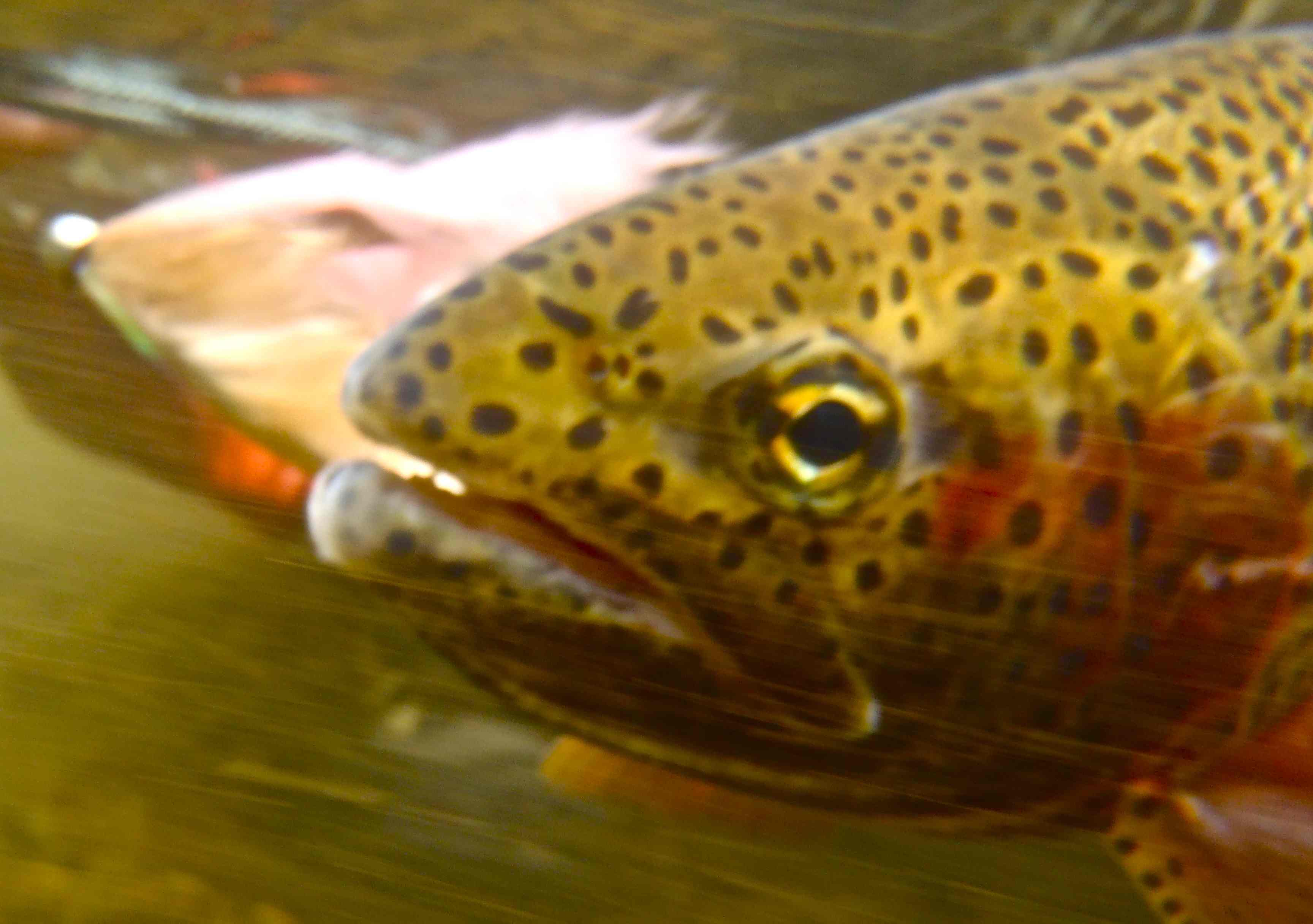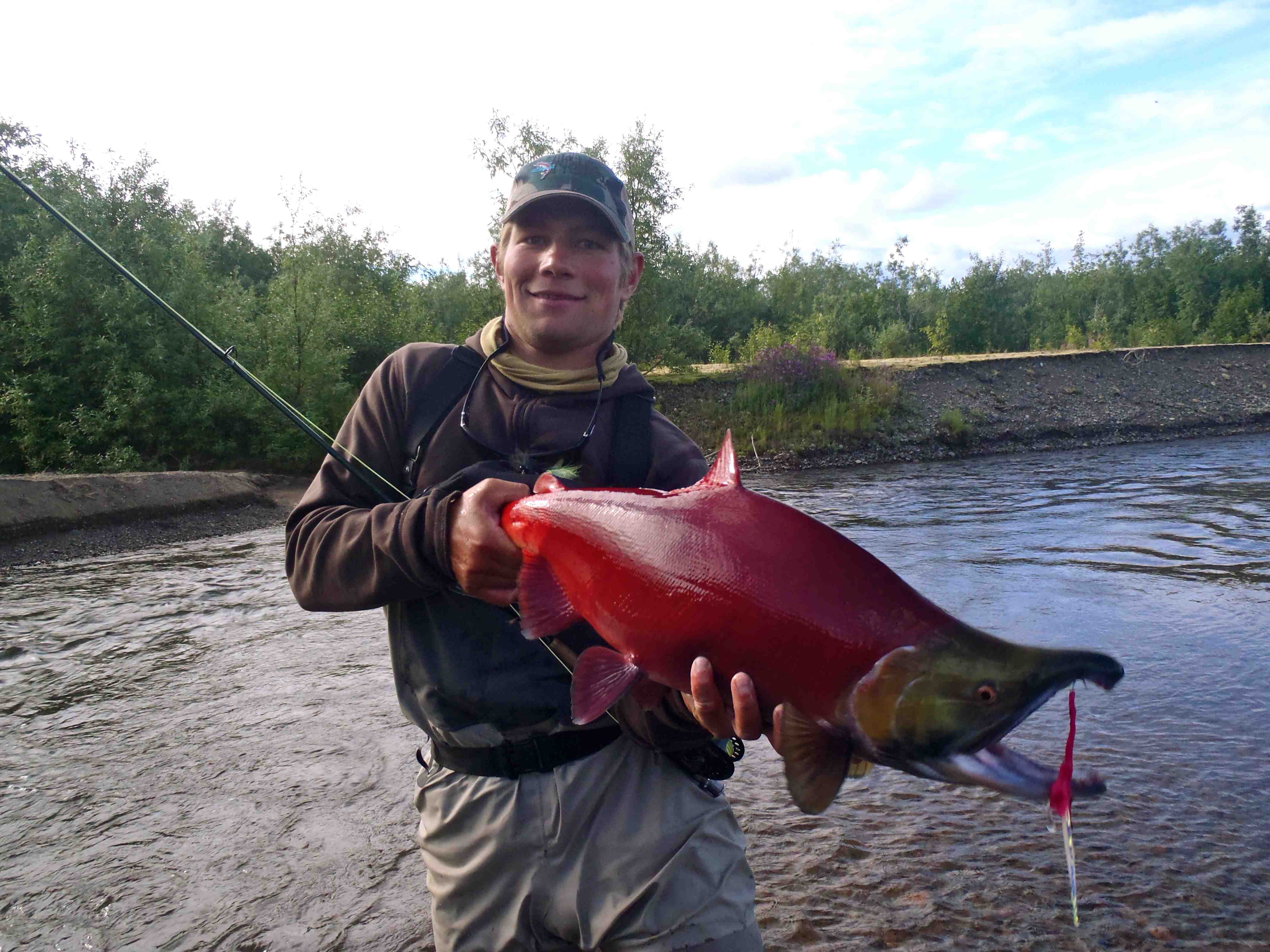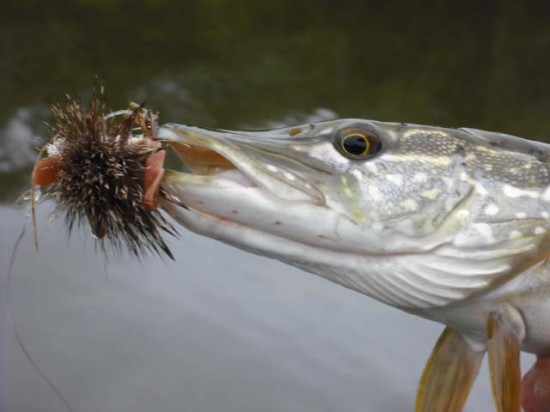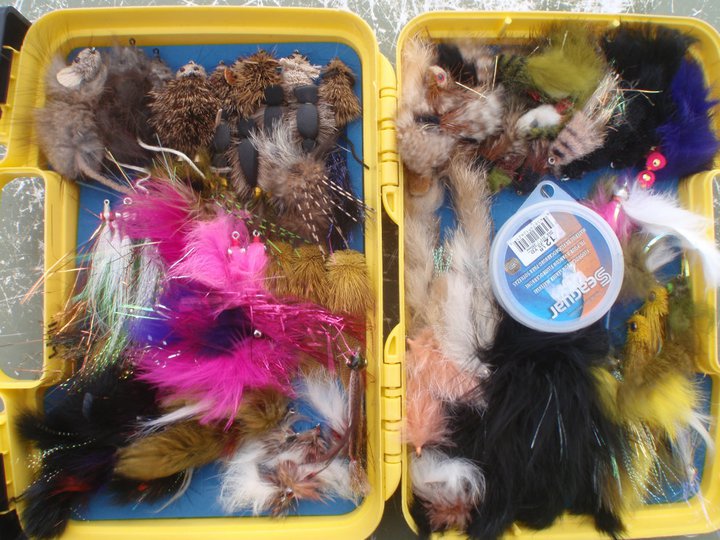Alaska Fly Selection: June (Part 1 of 3)
A Fly Selection for BRISTOL BAY, ALASKA
the Greatest Trout & Salmon Fishery in the World
Flies for 1 person for 1 week on a float trip or fishing with the region's best lodges. This is a multi species list, with an emphasis on June Rainbow Trout and Arctic Grayling, plus all of the other sport-fish in the Bristol Bay watersheds including Arctic Char, Lake Trout, early Kings, Sockeye, and Northern Pike. A short discussion follows.
First, don't leave home without these 5 items in your carry on luggage.
- Your best Polaroid glasses.
- Your Rx medications.
- Your favorite waterproof/breathable wading or fully waterproof rain jacket with retractors for hemostat and line nipper and 2 large pockets for fly boxes.
- Waders you completely trust which will get the equivalent of a full year of normal use during your AK trip.
- Wading boots that fit. Felt soles were outlawed in AK in 2012. The sticky rubber soles are now quite good. No "cleated, nailed, or studded" boots in rafts or cabins.
Why? In case Alaska Airlines loses you're checked bags with your clothing, rods, reels, and flies. You came a long way! Improvise and go fish!
Flies FOR Trout, Char, and Grayling
The Trout, Char, and Grayling flies below are proven in Bristol Bay, which is the finest completely intact, functional salmonid fishery in the world. When possible, tie or buy your patterns articulated or with stinger hooks for a significantly higher ratio of total fish landed (with less damage to fish mouthparts than traditional streamer hooks.) In the Bristol Bay region, please release ALL RAINBOW TROUT regardless of whether the Alaska Department of Fish and Game allows retention. It takes 10-15 years in cold Alaskan waters for a trophy trout to grow beyond 22 inches. Sockeye, Lake Trout, Char, and Grayling in June all provide great eating.
Your fly line(s) will determine to some extent how heavily weighted your flies should be. Cover your bases by bringing both a floating line and a sink tip. A full-sink line is not needed for our rivers and creeks.
Use your floating line in the headwaters and for "searching" as you work down river until water depths in the channels along the outside bends regularly exceed 3 feet and then, perhaps, switch to the sink tip. As you move down river you'll be pitching flies using the floating line with a weighted fly and perhaps an indicator. You are targeting root wad structure, deep green channels, and sweepers. The quarry is Rainbow Trout. One loses a lot of flies using this method, but, in June, this is where the fish are and you must fish in the woody debris and among broken chunks of sod left from spring flooding! Use fly lines like RIO Clouser which help turn over the large weighted flies with an aggressive weight forward taper. Cast aggressively to launch the leeches with lots of line speed. The 3"- 6" sink tip is very effective on Bristol Bay Rivers. If you have the "gift" you'll fish the sink tip both when drifting in the boat or wading and reap the rewards. If you don't have the "gift" you'll lose lots of flies and leaders fishing the sink tip while drifting from the boat and go back to the floating line and do very well.
Your rod choices: A #7 weight fly rod does it all. Some of my clients or friends bring two #7 wts and never 'look back'. A #4 is a fine rod for Arctic Grayling and trout under "ideal" (but somewhat rare) June conditions. The #5 weight & #6 weight make all purpose Trout/Char/Grayling rods but when you start fishing the weighted cone head Sculpins & Leeches the #7 weight can not be beat.
48 Trout Flies

- Sculpin patterns. Choose among various Sculpin patterns: Sculpzilla, Cone head, Rag, Woolhead, Exasperator, Loop, etc. Colors- olive, black. Size 2-4. Bring 4+ of your chosen pattern(s), 2 in each color.
- Egg sucking leech patterns. Choose among: Loop, Articulated Bunny, Sleech, Lead Eye, or Starlight, purple, olive, white, all purpose attractor. size #4-6. At least 2 should be purple. Bring 4+.
- Starlight leech. All white, good attractor for rainbow. Great color for Lake trout at your "put in lake". Bring 2.
- Haymaker Leech Conehead Eggabou size #1 black or blue. Consider it.
- Conehead Eggabou size #4 in pink or purple. Bring 2
- Dali Lama, Black & White, #6 all purpose attractor. Bring 2.
- Dali Lama, Green & White, #6. An option to substitute for traditional olive Sculpin.
- S&B Super string leech, or Pink rubber worm Sleech size #4 pink. Cold water Rainbows bring 2. Consider a selection of S&B Super string leech colors. A very fine fly.
- Mice bring 4+, Mr. Hanky, Loco, Preparation H Mouse, Moorish Mouse, Blair, Darth Skater, Mercers Lemming. You should have small bottle silicone floatant (not dry silica) for Mice and Caddis.
- Wooly bugger patterns in Olive, Black, Brown, size #4-6 bring 4.
- Nymphs, Hares ear, Pheasant Tail, Copper John etc. Bring 4. Fished as dropper in upper river or in cold water under an indicator.
- Trout beads, 8mm, natural roe and gold roe colors fished as dropper with "Owner" egg hooks. Bring 6. Fish as dropper where legal.
- Smolt & Fry. Stinger Clouser, Strung out Thunder Creek, Neil Creek Dart, Neil Creek Slider, Bring 4+ can be fished as dropper, streamer, or dead drifted under an indicator! Green & gold.
- Dry flies. For headwater through mid river when Grayling are rising. Elk Hair Caddis, Royal Wulff, Parachute Adams, Stimulator. High floating, high visibility. Size 14. Bring 6.
Total trout flies 48.
{gallery}/BlogContent/January2011/Flies1/Gallery{/gallery}- SALMON FLIES
- My presumption is that salmon are going to be targeted opportunistically in June on a mixed species trip. In most river systems salmon are just beginning to enter the river in late June. For salmon, generally, the articulated "Hareball", "Intruder", "Stinger Prawn", "String", "Critter", "Turbo" style leeches are replacing traditional (non articulated) leeches, due in part to their increased hooking/holding power plus better overall attractiveness. Bring various Pink, Orange, Chartreuse, Purple, Black and contrasting combinations in size #2- 2/0. Unlike relatively scarce but more aggressive King Salmon, the super abundant, extremely acrobatic Sockeye Salmon can be tough to entice to take leeches or streamers. You may see hundreds of sea bright Sockeye entering the rivers in the last week of June but except for the occasional "alpha" fish they can be frustratingly lock-jawed. You'll need a selection of very sparsely tied traditional wet flies specifically for Sockeye. Hint: You want to eat Sockeye for dinner!
- If Kings are the primary Salmon focus, then select a palette of colors and patterns while matching the sink rates of your sink tip line with the style/profile of the fly. Leaders for Kings should be in the 12-20# class. A #7 weight single handed rod for Sockeye & incidental Kings is okay but for a steady diet of King salmon a #9 weight is better. When a King is incidentally taken on a #5-6-7 weight rod be patient for the first 5-10 minutes and then for the salmon's sake use all the side pressure you can wield to get the fish to hand before it becomes severely depleted and anaerobic. Kings are a treasured Alaskan fishery resource like Rainbows. If you are going to kill a salmon on a Bristol Bay river, choose a Sockeye or a "jack" King. Release the mature King unharmed to spawn.
- 12 King Salmon flies:
- Articulated Hareball size 1/0-2/0, purple, black, pink, orange bring 6
- Intruder in combinations of Black, pink, purple, orange size 1 - 2/0, bring 6.
- Fish these or similar King patterns on the swing when searching holding water for fish. Kings like a slow, slow, slow presentation. However if you are sight fishing to a pod, dead drift the fly directly to the mouth of the target fish. Repeat presentations will jade them while sight fishing so your best chance is the first or second cast. Consider red/black combinations if Kings are finicky or have been in fresh water awhile.
- Spey flies, Tube flies, Prowler, Kilowatt, Critter, Conehead Popsicle, Sleech, Moal, Haymaker all have the attracting qualities needed for Kings. Substitute among patterns size 1- 2/0 for the style(s) you enjoy fishing at depths of 4-10 feet.
- 12 Sockeye Flies:

- Copper Swan #6 Bring 4. Red, Chartreuse, silver
- Sockeye Orange or Sockeye Special #4, #6 in orange and black Bring 2.
- Montana Brassie #4 also effective on Dollies & Rainbow Bring 2.
- Sockeye Lightning #6 bring 4 in ping and green.
- Red hot #6 consider it.
- Bring 12 Sockeye flies with red, chartreuse, orange, green, silver and pink among the colors. Dead drift these with an indicator set at the exact depth that you see fish holding or migrating. The take is very subtle. Sockeye are macro-plankton (shrimp) feeders at sea and don't have the alpha strike/chase response of Kings, Coho, or Chum. Once hooked, it can get wild! If they seem "lock-jawed" keep changing patterns and add split shot to get the presentation correct. If flossing or snagging begin to seem like an option, then move on and find a fresh pod.
- 8 Chum Flies:
- Popperwog. Chartreuse surface popper #2. Cut back your leader into the butt section toward #15-20 test. Fish poppers as a waking fly or "chug" it. Bring 2. This is fun!
- Starlight leech bring 4 in various colors including chartreuse/ white size #2-1/0.
- Hareball leeches Chartreuse #1/0. Bring 2.
- Chums will hammer most large salmon attractor patterns especially the color green so you don't have to bring special patterns other than the Popperwog. The Popperwog dry fly is the most fun. Chums destroy a disproportionate number of graphite fly rods. They are brutes. They also tear up your hands. Use pliers to unhook them or you'll be lacerated after a couple fish and need to duct tape your fingers.
- Total Salmon flies 28.
- 6 Northern Pike Flies:

- Mercers Lemming. When Pike want surface flies, you won't fish anything else. Bring 2+.
- Moal size #2 in combinations of Black, red, white, yellow, orange. Bring 4.
Total Pike flies 6.
NOTES ON LEADERS, INDICATORS, HEMOSTAT, LINE NIPPER, PLIERS, SOFT RELEASE NET, AND NON-SLIP LOOP KNOT.
Leaders: The 9 foot tapered RIO #10 pound tippet (or #6 tippet) Steelhead & Atlantic salmon leader is the best all purpose trout, char, grayling, miscellaneous salmon leader. 9 Foot Maxima is just as good. Bring 4 per week.
For Coho & Kings the RIO Steelhead & Atlantic salmon leader, 9 Foot 12# or 16# leader is what you want. Bring 3 per week. Bring a spool of RIO #10 pound and #15 pound "Max", "Powerflex", or Maxima tippet for rebuilding leaders.
There are some other good leaders besides Rio & Maxima including various "Big Game Fluorocarbon" but be extremely wary. You want to bring leaders, which are made of stiffer, thicker diameter monofilament to TURN OVER LARGE FLIES IN THE WIND and have 100% knot strength tied when in a "non-slip loop knot". Your leader is arguably more important than your fly or rod! Use relatively stiff, relatively hard monofilament leaders for Alaska trout for all situations except throwing dry flies. I watch fly casters waste hours and hours each week trying to use supple trout leaders in Alaska throwing weighted leeches. The leader should be labeled "Salmon," "Steelhead," "Big Game," "Bonefish," or "Bass". These are fundamentally different than ordinary trout leaders and designed to deliver heavier flies with fewer tangles. Fishing with the correct leader is your key to maximizing the number of fish caught in Alaska.
Indicators: Most of us have switched to "Thingamabobber" Indicators 1-inch size for larger flies, ¾ inch size for beads and smolt- bring 6. Yarn style with floatant is fine too.
Split shot: Size BB, 1 & 4, get the most use. The split shot brand I use is "Dinsmore" You crimp it on with a hemostat or pliers. I think it stays on longer than split shot with "wings".
Line Nipper: On a retractor.
Hemostat: on a retractor.
Pliers: on your wading belt.
Leave lanyard and chest pack at home. Just bring an efficient wading jacket with minimal stuff dangling to get caught in brush.
Soft release net: 24-30 inch handle and 20+ inch wide mouth. Big fish!
Knots: You need 1 knot for all the leech & streamer fishing in the Bristol Bay. Learn to tie the "non-slip loop knot". It breaks at 100% and will serve you well for Largemouth bass, Redfish, Tarpon, Taimen or anywhere that losing the fish of a lifetime might make you cry. The Improved clinch is adequate only for beads and droppers for trout. Use a "Riffle hitch" or "Turle" knot for mousing & "wogging".
Spare flies Organized in zip locks in your duffle bag along with anything else that doesn't live in your jacket pockets.
Windproof Lighter in jacket.
Deet bug dope: 1 small plastic spray bottle/week per person in Jacket pocket.
Over the years I've visit most of Alaska's fly shops. I've shopped many of the big lower '48 "full spectrum" fly shops, and some mega-Outdoor stores. Most of them don't have the selection or expertise to get all the flies you need for a Bristol Bay trip from a single vendor. The best all around shop that I've found for flies and Alaska tying materials is an on-line shop located in Juneau, Alaska called Alaska Fly fishing Goods. They are extremely good at what they do. Brad Elfers is the owner (907-586-1550). It's really informative to tell him the weeks(s) you'll be fishing and on what waters, and then ask for recommendations!
To produce this June Fly selection list for Bristol Bay I relied heavily on my 35 years of experience in Alaska exploring with a fly rod and from thousands of riverbank discussions with other guides and Alaskan residents. You should know for planning purposes that June is still early spring. Fishing in June is not so much about Salmon but rather the resident species like Rainbows and Grayling, which are hungry after spawning. Aquatic insects, Snails, Smolt, Sculpin, Lamprey, Stickleback, and Fry are their mainstay
This list assumes that your partner will lend you what you run out of or what you did not bring! You should be able to organize these in one large fly box for all the large leeches and salmon flies needed for the day plus one other smaller box for Eggs, Smolt, and a few dries in your other jacket pocket. June is a too early for the salmon spawn so I won't address dead drifting beads through active redds, but, if your trip extends far into July, you will want a separate box of beads purchased as a kit specifically for the weeks and salmon species spawning.
This list also assumes you will be fishing with recommended Salmon / Steelhead leaders in #6-10 class for Trout, Dolly Varden Char, Grayling, Arctic Char, leaders in #10 class for Lake Trout, Chum, and Sockeye. King Salmon and Northern Pike require #16-#20 although a true minimalist can do it all on 10# tippet. Heavier leaders for trout helps us minimize the number of flies left on the river bottom/overhanging trees and to minimize stress to the fish. The trout are rarely leader shy in remote waters (particularly prior to the salmon spawn) and the salmon are not leader shy.
